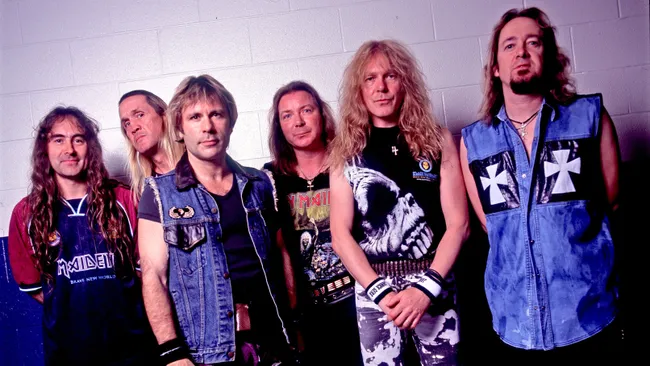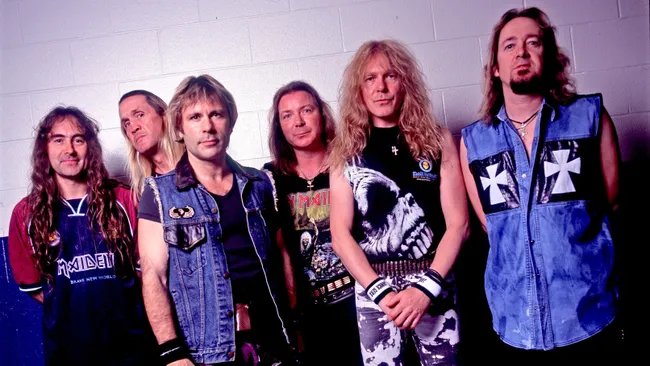
When Bruce Dickinson rejoined Iron Maiden in 1999, fans celebrated one of the most significant reunions in metal history. But behind the scenes, bassist and bandleader Steve Harris wasn’t immediately convinced it was the right move. His recent reflections reveal a more complex emotional journey, one marked by caution, skepticism, and ultimately, reconciliation.

A Shocking Return That Wasn’t Instantly Embraced
Bruce Dickinson’s exit from Iron Maiden in 1993 was dramatic, public, and painful for Harris. As the architect of Maiden’s vision and one of its founding members, Harris felt both blindsided and disappointed. The relationship between the two had frayed, and Dickinson’s solo ambitions, particularly his desire for creative freedom, had stirred tensions within the band.
So when management began floating the idea of Bruce returning six years later, Harris didn’t jump for joy. Far from it.
“When Bruce came back I wasn’t 100% sure of the reasons behind it,” Harris admitted. “I was like, ‘Well, okay, let’s see.’ I’ll be honest – I wasn’t sure.”
The hesitation wasn’t about Bruce’s talent. It was about trust.
A Band Shaped By Scars
Iron Maiden had endured multiple lineup changes, fracturing relationships, and the uncertain years of the Blaze Bayley era, a period Harris has always defended but acknowledges was challenging. Reuniting with Dickinson and guitarist Adrian Smith meant reopening old wounds, revisiting unresolved frustrations, and risking new conflicts.
For Harris, who built Maiden on loyalty and stability, it was a big ask.
His hesitation came down to one question:
Was Bruce returning because he genuinely loved Maiden, or simply because he needed Maiden?
Rediscovering Chemistry In The Studio
The turning point came not through conversation, but through music.
Once the reunited lineup entered the studio to begin work on Brave New World, Harris saw something shift. Dickinson was committed, energized, and, for the first time in years, completely aligned with the band’s creative direction. The spark that fueled Maiden in the ’80s was not only alive, but stronger.
Harris later reflected that it didn’t take long for the joy of collaboration to push aside the doubt:
“Once we started writing again, it felt right. Everything just clicked. I realised Bruce was back for the right reasons, because he wanted to be part of the band, not above it.”
The sessions recaptured a chemistry that had been buried beneath years of tension. The resulting album wasn’t just a comeback, it was a rebirth.
Building Peace Through Purpose
For Harris, making peace with Bruce wasn’t about forgiveness or forgetting the past. It was about recognizing growth.
Dickinson returned more grounded, more mature, and more appreciative of Maiden’s legacy. Harris returned more open, more communicative, and more willing to share leadership. Both men had changed, and that change is what allowed Iron Maiden to move forward.
Their partnership, once strained, evolved into something stronger: mutual respect reinforced by decades of shared battles.
A Reunion That Reshaped Heavy Metal
The Harris–Dickinson reconciliation shaped the next 25 years of Iron Maiden’s career, fueling some of their most ambitious albums, Brave New World, A Matter of Life and Death, The Book of Souls, and Senjutsu. It also powered tours that reasserted Maiden as one of the most important live acts on the planet.
Looking back, Harris’ initial skepticism seems almost prophetic. His caution ensured the band made the right decision for the right reasons, and it ultimately allowed Iron Maiden to thrive rather than simply reunite for nostalgia.
“Let’s See” Became “We’re Better Than Ever”
Steve Harris may not have been convinced the day Bruce Dickinson walked back into the room. But through music, honesty, and shared purpose, the two rebuilt their partnership and propelled Iron Maiden into a new golden era.
What began with “Well, okay, let’s see” became one of the most successful second chapters in metal history.
Leave a Reply